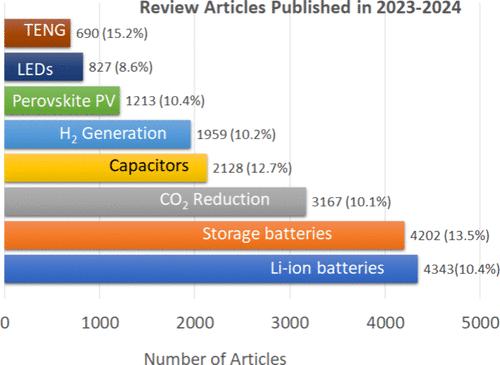Should You Really be Writing A(nother) Review Manuscript?
IF 18.2
1区 材料科学
Q1 CHEMISTRY, PHYSICAL
引用次数: 0
Abstract
Figure 1. Review articles on a few popular energy research topics published in 2023–2024 (TENG refers to Tribo Electric Nano Generators, and LEDs refers to Light Emitting Diodes). The legends include the numbers of review articles and the percentages as part of all published peer review articles. Source: Web of Science, Clarivate (retrieved and analyzed on July 7, 2025). Editorial challenges. Whereas scientific articles provide new research advances, review articles are composed based on published literature. As a result, review articles are seldom rejected by journals on scientific grounds after peer review unless they are poorly composed and difficult to comprehend. The number of review articles on a given topic depends on its popularity. For popular topics such as halide perovskites, storage batteries, and LEDs, the number of review articles can reach thousands each year (see Figure 1), making it difficult to assess novelty and impact. Except for a few well-thought-out reviews in each category, others merely serve as placeholders, repeating already summarized content, hoping to get cited. Citation practices. Citing review articles in the introduction of a manuscript is a common practice since the authors do not need to give a full literature survey. Authors often look for the most-cited reviews so their citations remain credible. Just ask any author how many review articles they fully read before citing them in a manuscript. Superficial reviews. The ease of compiling literature through various databases has led to a rise in review articles, sometimes authored by groups who repeatedly publish on trending topics without offering new insights or critical analysis, compiling literature with no specific data analysis, critique, or detailed discussion. Although these articles are likely to be scientifically correct, they are not likely to contribute to the advancement of scientific literature. As authors, we really need to ask ourselves: Is there more room and need for another review on the same popular topic after many similar review papers have been published over the previous years? (2) Just like original research papers, the novelty (timeliness) of a review manuscript could have a significant impact on its significance and usefulness to the research community (i.e., in practical terms, the future citations). The idea of “novelty” of a review has not often been considered when making editorial decisions on accepting a review paper, but now it is becoming important as duplicative articles appear throughout literature. AI-Generated content. The availability of AI tools has made writing even easier. (3−6) LLM Tools like ChatGPT have accelerated the production of papermill activity and review articles, including those generated with minimal human input that only summarize the latest developments in a scientific field with key references. (7) The authors thank Dr. González Miera for helpful discussions This article references 9 other publications. This article has not yet been cited by other publications.

你真的应该写一篇(另一篇)评论稿件吗?
图1所示。2023-2024年发表的一些热门能源研究主题的评论文章(TENG指的是摩擦纳米发电机,led指的是发光二极管)。图例包括评论文章的数量和作为所有发表的同行评议文章的一部分的百分比。来源:Web of Science, Clarivate(检索和分析于2025年7月7日)。社论的挑战。科学文章提供新的研究进展,而评论文章是根据已发表的文献撰写的。因此,评论性文章很少在同行评议后被期刊以科学理由拒稿,除非它们写得很差,难以理解。一个给定主题的评论文章的数量取决于它的受欢迎程度。对于诸如卤化物钙钛矿、蓄电池和led等热门主题,每年的评论文章数量可达数千篇(参见图1),因此很难评估其新颖性和影响。除了每个类别中少数经过深思熟虑的评论外,其他评论只是作为占位符,重复已经总结的内容,希望被引用。引用实践。在一篇论文的引言中引用综述文章是一种常见的做法,因为作者不需要给出完整的文献综述。作者通常会寻找被引用次数最多的评论,这样他们的引用才会可信。随便问一个作者,他们在引用一篇评论文章之前完全阅读了多少篇。肤浅的评论。通过各种数据库编辑文献的便利性导致了评论文章的增加,有时由反复发表热门话题而没有提供新见解或批判性分析的小组撰写,没有具体数据分析,批评或详细讨论的文献。虽然这些文章可能在科学上是正确的,但它们不太可能对科学文献的进步做出贡献。作为作者,我们真的需要问自己:在前几年发表了许多类似的综述论文之后,是否还有更多的空间和需要对同一个热门主题进行另一篇综述?(2)就像原始研究论文一样,综述稿件的新颖性(时效性)可能会对其在研究界的重要性和有用性(即,在实践中,未来的引用)产生重大影响。在编辑决定是否接受一篇评论论文时,通常不会考虑评论的“新颖性”,但现在随着文献中重复文章的出现,它变得越来越重要。AI-Generated内容。人工智能工具的可用性使写作变得更加容易。(3−6)ChatGPT等法学硕士工具加速了造纸厂活动和评论文章的生产,包括那些仅用关键参考文献总结科学领域最新发展的人工投入最少的文章。(7)作者感谢González Miera博士的有益讨论。本文引用了其他9篇出版物。这篇文章尚未被其他出版物引用。
本文章由计算机程序翻译,如有差异,请以英文原文为准。
求助全文
约1分钟内获得全文
求助全文
来源期刊

ACS Energy Letters
Energy-Renewable Energy, Sustainability and the Environment
CiteScore
31.20
自引率
5.00%
发文量
469
审稿时长
1 months
期刊介绍:
ACS Energy Letters is a monthly journal that publishes papers reporting new scientific advances in energy research. The journal focuses on topics that are of interest to scientists working in the fundamental and applied sciences. Rapid publication is a central criterion for acceptance, and the journal is known for its quick publication times, with an average of 4-6 weeks from submission to web publication in As Soon As Publishable format.
ACS Energy Letters is ranked as the number one journal in the Web of Science Electrochemistry category. It also ranks within the top 10 journals for Physical Chemistry, Energy & Fuels, and Nanoscience & Nanotechnology.
The journal offers several types of articles, including Letters, Energy Express, Perspectives, Reviews, Editorials, Viewpoints and Energy Focus. Additionally, authors have the option to submit videos that summarize or support the information presented in a Perspective or Review article, which can be highlighted on the journal's website. ACS Energy Letters is abstracted and indexed in Chemical Abstracts Service/SciFinder, EBSCO-summon, PubMed, Web of Science, Scopus and Portico.
 求助内容:
求助内容: 应助结果提醒方式:
应助结果提醒方式:


